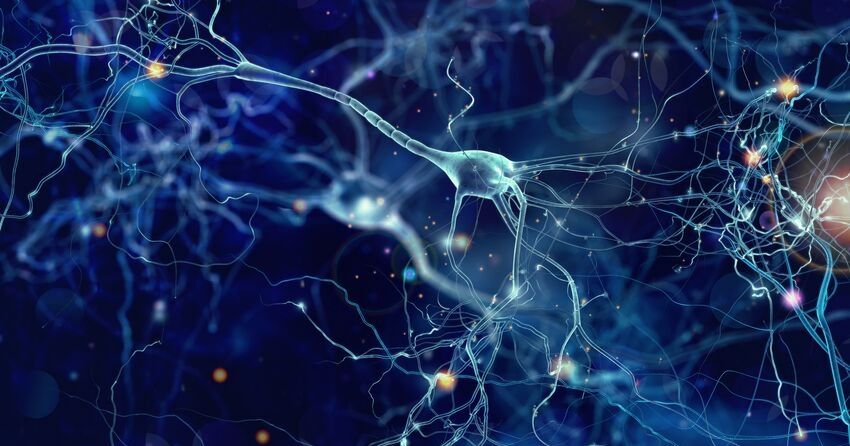Regenerate Damaged Nerves by Boosting Cellular Energy

-
Increasing the energy supply (ATP) in damaged spinal cord nerves may promote regeneration and regrowth of axons (nerve fibers).
-
Damaged axons in spinal cord injuries can impair ATP production by also damaging nearby mitochondria and anchoring them in place.
-
In mice given creatine (which enhances ATP formation), axon regrowth increased, especially in mice who were lacking the protein that tethers the damaged mitochondria in axons.
This article was posted on National Institute of Neurological Disorders and Stroke News:
When the spinal cord is injured, the damaged nerve fibers—called axons—are normally incapable of regrowth, leading to permanent loss of function. Considerable research has been done to find ways to promote the regeneration of axons following injury. Results of a study performed in mice and published in Cell Metabolism suggests that increasing energy supply within these injured spinal cord nerves could help promote axon regrowth and restore some motor functions. The study was a collaboration between the National Institutes of Health and the Indiana University School of Medicine in Indianapolis.
“We are the first to show that spinal cord injury results in an energy crisis that is intrinsically linked to the limited ability of damaged axons to regenerate,” said Zu-Hang Sheng, Ph.D., senior principal investigator at the NIH’s National Institute of Neurological Disorders and Stroke (NINDS) and a co-senior author of the study.
Like gasoline for a car engine, the cells of the body use a chemical compound called adenosine triphosphate (ATP) for fuel. Much of this ATP is made by cellular power plants called mitochondria. In spinal cord nerves, mitochondria can be found along the axons. When axons are injured, the nearby mitochondria are often damaged as well, impairing ATP production in injured nerves.
“Nerve repair requires a significant amount of energy,” said Dr. Sheng. “Our hypothesis is that damage to mitochondria following injury severely limits the available ATP, and this energy crisis is what prevents the regrowth and repair of injured axons.”
Adding to the problem is the fact that, in adult nerves, mitochondria are anchored in place within axons. This forces damaged mitochondria to remain in place while making it difficult to replace them, thus accelerating a local energy crisis in injured axons.
The Sheng lab, one of the leading groups studying mitochondrial transport, previously created genetic mice that lack the protein—called Syntaphilin—that tethers mitochondria in axons. In these “knockout mice” the mitochondria are free to move throughout axons.
“We proposed that enhancing transport would help remove damaged mitochondria from injured axons and replenish undamaged ones to rescue the energy crisis,” said Dr. Sheng.
To test whether this has an impact on spinal cord nerve regeneration, the Sheng lab collaborated with Xiao-Ming Xu, M.D., Ph.D. and colleagues from the Indiana University School of Medicine, who are experts in modeling multiple types of spinal cord injury.
“Spinal cord injury is devastating, affecting patients, their families, and our society,” said Dr. Xu. “Although tremendous progress has been made in our scientific community, no effective treatments are available. There is definitely an urgent need for the development of new strategies for patients with spinal cord injury.”
When the researchers looked in three injury models in the spinal cord and brain, they observed that Syntaphilin knockout mice had significantly more axon regrowth across the injury site compared to control animals. The newly grown axons also made appropriate connections beyond the injury site.
When the researchers looked at whether this regrowth led to functional recovery, they saw some promising improvement in fine motor tasks in mouse forelimbs and fingers. This suggested that increasing mitochondrial transport and thus the available energy to the injury site could be key to repairing damaged nerve fibers.
To test the energy crisis model further, mice were given creatine, a bioenergetic compound that enhances the formation of ATP. Both control and knockout mice that were fed creatine showed increased axon regrowth following injury compared to mice fed saline instead. More robust nerve regrowth was seen in the knockout mice that got the creatine.
“We were very encouraged by these results,” said Dr. Sheng. “The regeneration that we see in our knockout mice is very significant, and these findings support our hypothesis that an energy deficiency is holding back the ability of both central and peripheral nervous systems to repair after injury.”
Dr. Sheng also points out that these findings, while promising, are limited by the need to genetically manipulate mice. Mice that lack Syntaphilin show long-term effects on regeneration, while creatine alone produces only modest regeneration. Future research is required to develop therapeutic compounds that are more effective in entering the nervous system and increasing energy production for possible treatment of traumatic brain and spinal cord injury.





